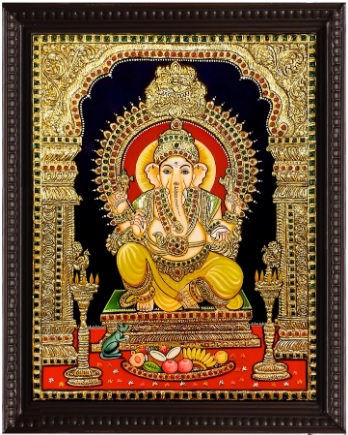
Making Tanjore paintings at home is hobby followed by many art enthusiasts and hobbyists. It involves series of activities starting with Board Preparation. Lets check the details below on how to make Tanjore Paintings at home
Tanjore Painting or “Thanjavur painting” is a classical South Indian painting style, which was inaugurated from the town of Thanjavur, Material: canvas, paint, wood, Thanjavur paintings are characterised by rich and vivid colors, simple iconic composition, glittering gold foils overlaid on delicate but extensive gesso work and inlay of glass beads and pieces or very rarely precious and semi-precious gems, Essentially serving as devotional icons, the subjects of most paintings are Hindu gods, goddesses, and saints, Thanjavur paintings are panel paintings done on wooden planks.
How to make Tanjore Paintings at Home
A good description of this process if provided here, and is reproduced below for easy reference
The board thickness depends on the size of the painting. It is best to use at least 8mm thick water proof board so that it will not bend under the weight. Cut a piece of gaada (unbleached) cloth free from starch which is atleast 1 inch bigger than the board on all sides.
Make a thin paste by mixing water to white glue (4:1 ratio). Soak the cloth in the white glue water mixture. Squeeze to remove excess glue. Stretch this cloth on the board and gently smoothen the cloth from centre to the edges making sure there are no wrinkles. Paste the excess cloth firmly on the reverse side using white glue.
Mix chalk powder, white glue and water in the ratio 2:1:1.5. Apply three coats of this mixture on the board using a flat 2″ brush. If the first coat is applied in the horizontal direction, the second can be in the vertical direction. In between each coat, allow time to dry and smoothen the board with fine emery paper. After the final coat, allow the board to dry for a day.
If you see small pores on board, Try smoothening with emery paper (smooth paper) and then apply another coat. Also try thinning the paste if it is too thick. It should spread easily on the board and should not be thick and patchy.
There is no real hard and fast rule about the ratio. Depending on the type and brand of chalk powder and white glue, the ratio varies. When you rub with emery paper if almost all of the layer is powdered off, then you need to add more fevicol. When you rub, if nothing comes off and you are not able to smoothen the board at all, then reduce the amount of fevicol. When in doubt, smoothen the board with emery paper and then apply the next coat.
Finally you can use a heavy glass paperweight or bottle to smoothen the surface.
Paste a newspaper sheet on the reverse to cover the rough folded cloth. Smoothen the board with emery paper and then with a rounded glass bottle or paper weight to get the smooth finished board. (if it is a plank, it is better not to cover the back, allowing space for the plank to breathe)
Std board sizes: 10×8 ; 15×12 ; 16×15 ; 20×16 ; 18×24 ; 24×30 ; 24×36 ; 36×48 (inches)
Wood used: Wooden planks such as Teak, jackwood (palaa maram) or water proof, termite proof plywood.
Tracing the pattern
On the preapred board, draw a 1 cm border. This allowance is to make space for the framing.
Allow space for a border – gold lines – of dots, stones or mirrors.
Then trace the selected picture on the board using yellow or red carbon.
Pasting stones
Paste the stones using white glue at the required spots.
Muck preparation
Muck is the paste that is used to create the embossed effect in Tanjur painting – the gold foil is later pasted over these raised areas.
The muck is prepared using arabic gum and chalk powder (putty chalk powder or french chalk powder). It is best to prepare the muck a few days ahead of use to make it pliable for use.
Soak the crystal gum in water, so that the crystals are completely immersed. Leave it for 2-3 days. Stir and filter the gum using a fine cloth to get a clear gum solution, neither too watery nor too thick.
French chalk powder is finer and whiter than putty chalk powder. There are different grades of putty chalk powder available and the ratio of the mixture will depend upon your brand. Please prepare accordingly. The paste should be neither too thick to be patchy nor too runny.
The proportion for muck
Mix 3 portions putty chalk powder / french chalk powder with 1 portion arabic gum.
This thick muck can be used for the final intricate designs which can be created either with a brush or a cone.
Soak the chalk powder in water for a long period (months) for best results.
(Putty chalk needs straining. Make a very thick paste of the putty chalk and use a tea strainer to make a thick smooth paste and use this paste for making the muck.You can also strain it after mixing the chalk powder and gum.)
The muck is usually applied to the board in 3 consistencies.
1. The first level when applying over stones is thin – you should be able to drop it on to the board.
2. At the second level, when applying on plain areas without stones, it should be thicker.
3. Finally when doing the intricate design work it should be even thicker.
To test the consistency of the muck, drop a little on to a board to form a smooth round sphere. When it is dry it should be smooth. Then the consistency is right. If it dips in at the centre, there is too much gum and if it cracks, then there is too much chalk powder.
The intricate embossed designs can also be applied using a cone prepared out of plastic paper.
Applying Muck
Apply the first level of muck over the stones. To the thick muck add a little thin gum solution. (it is suggested that it is always better to add very thin gum to dilute the muck rather than water). Mark an outline around the stones to prevent the muck from running. Now drop the muck over the stones. Do not brush too hard. Just use the brush to guide the muck into the gaps. Make sure the entire area is covered smoothly. The muck will automatically settle down smoothly over the area. Allow to dry.
Allow the muck applied on the stones to dry completely. Brush some water on the dry muck and rub gently in circular motion with a moist cloth to wipe off the the muck on the stones, ensuring that the surrounding area is not damaged. Before wiping off the muck, draw the outlines of the figure using a water proof pen, so that the traced image is not wiped off when cleaning the stones.
Then create the second level of embossed designs with the medium muck – lines, dots big and small.
When this is dry, make the third level of designs with the thickest muck – the thin lines around the stones and other designs. Allow the muck work to dry completely.
Prepare a very thin watery solution of the muck. This muck solution can be applied over the entire board. This will give a very smooth surface and the pasted gold foil will look smooth and finished.
Now stick gold foil on all the embossed areas. Place the gold foil on the area, press, take the impression and cut out the foil with a few mm allowance. Apply gum on the reverse, paste the gold foil and press lightly with a thin fine cloth, making sure the gold foil does not move out of position or tear. Then press well so that the impressions are clear and there are no gaps or air pockets. When all the muck has been covered with foil, cut off all the excess foils around the design. Scrape out the foil on the stones with a sharp needle or pin.
Paint the design.

